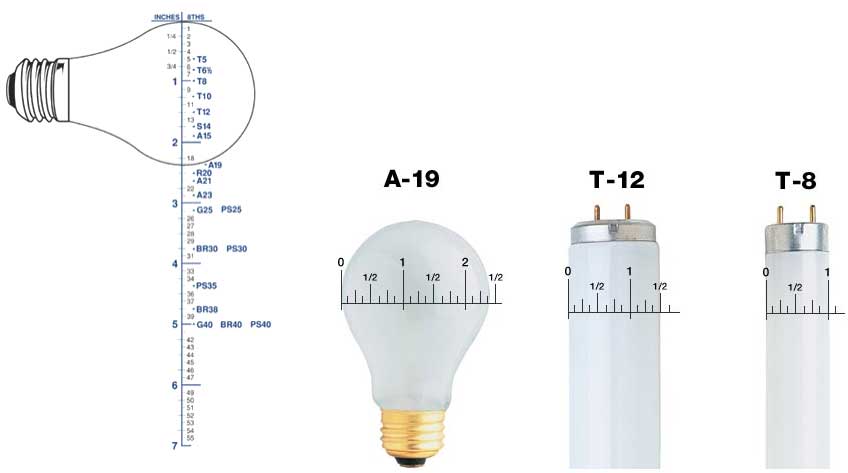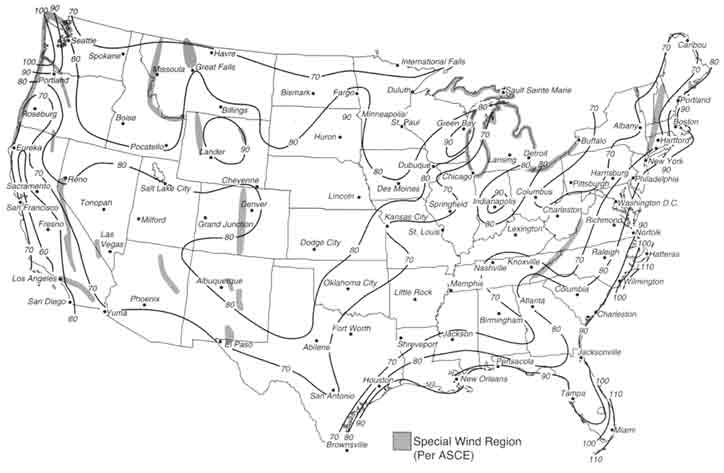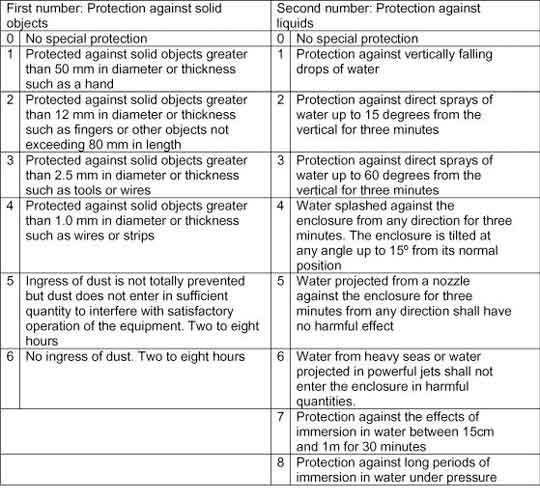AMP – Watts Divided by Volts.
Jump to top of page
ANSI – American National Standards Institute. The organization that develops voluntary guidelines and produces performance standards for the electrical and other industries.
Jump to top of page
AT (Air Tight) Rated – This means that any housing with the “Air Tight” rating is approved and made to be sealed so as not to allow air to escape through it into your ceiling or attic.
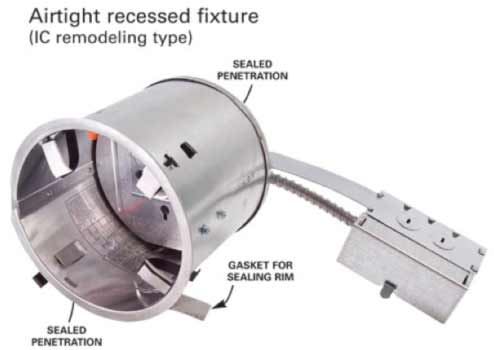
AVERAGE RATED LIFE – An average rating, in hours, indicating when 50% of a large group of lamps have failed, when operated at nominal lamp voltage and current.
Jump to top of page
BACKLIGHT, UPLIGHT, AND GLARE (BUG) RATINGS – Backlight, Uplight, and Glare ratings may be used to evaluate luminaire optical performance related to light trespass, sky glow, and high angle brightness control. These ratings are based on a zonal lumen calculations for secondary solid angles defined in TM-15-07. The zonal lumen thresholds listed in the following three tables are based on data from photometric testing procedures approved by the Illuminating Engineering Society for outdoor luminaries (LM-31 or LM-35).
Jump to top of page
BALLAST – A device which provides the necessary starting voltage and appropriate current to a fluorescent or high intensity discharge (HID) luminaire.
Jump to top of page
BALLAST FACTOR – One of the most important ballast parameters for the lighting designer/engineer is the ballast factor. The ballast factor is needed to determine the light output for a particular lamp-ballast system. Ballast factor is a measure of the actual lumen output for a specific lamp-ballast system relative to the rated lumen output measured with a reference ballast under ANSI test conditions (open air at 25 degrees C [77 degrees F]). An ANSI ballast for standard 40-watt F40T12 lamps requires a ballast factor of 0.95; the same ballast has a ballast factor of 0.87 for 34-watt energy saving F40T12 lamps. However, many ballasts are available with either high (conforming to the ANSI specifications) or low ballast factors (70 to 75%). It is important to note that the ballast factor value is not simply a characteristic of the ballast, but of the lamp-ballast system. Ballasts that can operate more than one type of lamp (e.g., the 32-watt F32 ballast can operate either 32-watt F32T8, 25-watt F25T8, or 17-watt F17T8 lamps) will generally have a different ballast factor for each combination.
Ballast factor is not a measure of energy efficiency. Although a lower ballast factor reduces lamp lumen output, it also consumes proportionally less input power. As such, careful selection of a lamp-ballast system with a specific ballast factor allows designers to better minimize energy use by “tuning” the lighting levels in the space. For example, in new construction, high ballast factors are generally best, since fewer luminaires will be required to meet the light level requirements. In retrofit applications or in areas with less critical visual tasks, such as aisles and hallways, lower ballast factor ballasts may be more appropriate.
To avoid a drastic reduction in lamp life low ballast factor ballasts.
Finding the ballast factor for lamp-ballast combinations may not be easy, as few ballast manufacturers provide this information in their catalogs. However, if the input power for a particular lamp-ballast system is known (usually found in catalogs) an estimate of the ballast factor is possible.
Jump to top of page
BCT – Ballast Case Temperature. The measured operating temperature of a fixture’s ballast. Operating outside of a ballast’s specified operating temperature will shorten its functional lifespan.
Jump to top of page
BEAM ANGLE – Beam angles refer to the degree of width in which light emanates from the light source. The angle between those points on either side of the beam is where the light’s intensity drops to about 50%.
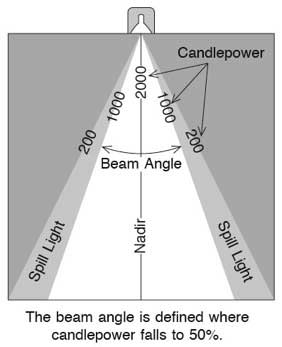
Jump to top of page
BULB SHAPE AND SIZE – The lighting industry has developed standards for incandescent bulb sizes that have been in use for many years. Table lamp and lighting fixture manufacturers use these sizes to design their products. In the US incandescent bulb diameters are measured in 1/8 of an inch increments. The lighting industry identifies bulb shapes and sizes by a letter and number code. For example the typical 60 Watt incandescent light bulb would be called an “A19” lamp. The “A” tells us that it has the standard bulb shape that is typical for table lamps. The number “19” tells us that the lamp is 19, 1/8ths of an inch in diameter or 19/8 = 2.375 inches.
Some of the more common household shape codes are:
- A – Standard “Pear Shaped” light bulb. Typically used in table lamps and enclosed ceiling fixtures.
- BR – Bulged Reflector
- R – Reflector. Typical used in recessed fixtures.
- C – Candelabra or Chandelier. Typically used in chandeliers or ceiling fans. Lamp shapes can vary including flame tip or torpedo.
- G – Globe type bulb. Typical use might be in a bathroom vanity fixture.
- PAR – Parabolic Aluminized Reflector. Typically used outdoors and has a thicker glass envelope to withstand weather in uncovered fixtures. Can also be used indoors in track lighting. PAR lamps produce a controlled beam of light that can be narrow beam like a spotlight or wider beam to provide aim able general lighting for an area.
- MR – Miniature Reflector. Not common in older household fixtures. Typically used as spot lighting for small areas such as over the sink fixtures or a food prep island. MR lamps resemble the reflector in a common flashlight. The recommended energy efficient replacements for incandescent MR lamps are LED. The most common size is MR16.
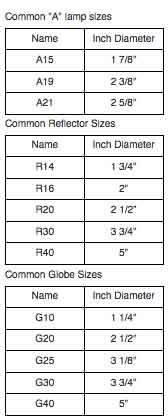
CANDELA – The candela (abbreviation, cd) is the standard unit of luminous intensity in the International System of Units ( SI ). It is formally defined as the magnitude of an electromagnetic field, in a specified direction, that has a power level of 1/683 watt (1.46 x 10 -3 W) per steradian at a frequency of 540 terahertz (540 THz or 5.40 x 10 14 Hz ).
Originally, luminous intensity was measured in terms of units called candles. This expression arose from the fact that one candle represented approximately the amount of visible radiation emitted by a candle flame. This was an inexact specification because burning candles vary in brilliance. So, for a time, a specified amount of radiation from elemental platinum at its freezing temperature was used as the standard. Late in the 20th century, the current definition and terminology were adopted.
The quantities comprising the specification of the candela are obscure to some non-scientists. An EM-field power level of 1.46 x 10 -3 W is small; the radio-frequency (RF) output of a children’s toy two-way radio is several times that much. A frequency of 540 THz corresponds to a wavelength of about 556 nanometers (nm), which is in the middle of the visible-light spectrum. A steradian is the standard unit solid angle in three dimensions; a sphere encloses 4 pi (approximately 12.57) steradians.
For more information click here https://en.wikipedia.org/wiki/Candela
Jump to top of page
CEE – CEE is a consortium of efficiency program administrators from across the U.S. and Canada who work together on common approaches to advancing efficiency. Through joining forces, the individual efficiency programs of CEE are able to partner not only with each other, but with other industries, trade associations, and government agencies. By working together at CEE, administrators leverage the effect of their funding dollars, exchange information on effective practices and, by doing so, achieve greater energy efficiency for the public good. (Visit CEE website.)
Jump to top of page
COLOR TEMPERATURE – See Kelvin Temperature.
Jump to top of page
CONTROLS (Protocols) See below for control types
Jump to top of page
- Analog (0-10V)

Analog dimming, often called 0-10V dimming, is defined in the IEC 60929 (Annexe E) standard, and uses a control wire separate from the AC input to provide the 0-10V dimming signal. The dimmer control – a dedicated 0-10V wall dimmer or a circuit in a control system – acts as a current sink, allowing one signal to control several luminaires/ballasts in parallel. When the dimming input is 10V the output is full brightness, with a linear reduction to zero as shown in Fig. 1. If the dimming input in a luminaire is not used it can simply be left open-circuit and is internally pulled up to 10V.
In a 0-10V scenario, a luminaire can use either a linear control of the output current or a variable PWM output to dim the LEDs. Fig. 2 shows a block diagram of a power supply and driver with linear output dimming. Note that the 0-10V signal controls the LED driver current, not the power supply output voltage which remains constant (24V in this example).
The chart shows a block diagram of a power supply with analog control that relies on a PWM output for dimming. In this case the 0-10V signal is input to a PWM controller in the power supply that provides a constant-voltage variable-pulse-width output via a MOSFET switch. An LED driver (not shown in chart) would convert the pulses to constant current and drive the LEDs. A PWM frequency of 200Hz avoids any noticeable flicker of the light output.
Jump to top of page
- *Simple Dimming
Uses the signal control to do both functions, dim and power on and off. This results in less time and material to install, no relay power pack to purchase and no extra wires to tie into ballast.
Jump to top of page
- *Traditional Dimming
Requires wall dimmer & relay pack, it requires two sets of wires for each system, one set of wires to dim the product, one set of wires to turn the product on and off.
Jump to top of page
- DALI digital controls
Moving on to digital interfaces, the digital addressable lighting interface (DALI) standard is also defined in IEC 60929, Annexe E. The main application for DALI is the control of multiple light fixtures in commercial applications such as conference rooms, offices and public buildings. One DALI interface can control up to 64 devices. All devices on a DALI network are controlled by an electronic control device (ECD), which can also include an Ethernet interface to allow the network to be administered from a PC.
DALI provides comprehensive dimming capabilities based on stored information for different brightness configurations, referred to as scenes. The DALI protocol allows control of brightness and of dimming speed within each luminaire, to coordinate all luminaires on a network and ensure they all react simultaneously. DALI also allows for status reporting from each device to the controller on request, including brightness setting as well as power status, fault information, etc.
provides comprehensive dimming capabilities based on stored information for different brightness configurations, referred to as scenes. The DALI protocol allows control of brightness and of dimming speed within each luminaire, to coordinate all luminaires on a network and ensure they all react simultaneously. DALI also allows for status reporting from each device to the controller on request, including brightness setting as well as power status, fault information, etc.
For LED lighting in a DALI network, the dimming itself can be achieved through normal PWM control of the LED drive current. The same microcontroller that provides the DALI interface functionality can also provide the PWM signal to the LED driver.
Jump to top of page
- DMX512
The DMX512 (digital multiplex) standard is defined in ANSI E1.11-2004. Its main use is to control theater stage lighting, and it can support multiple functions such as pan, tilt, zoom, color and image effects in addition to dimming. A maximum of 32 devices can be connected on one DMX512 line. DMX data flow is unidirectional and does not include any provision for status reporting.
Dimming is normally implemented in one of two ways.  The first method uses a specific DMX dimmer unit (called a dimmer pack) that provides several AC outputs into which lights are plugged. Each of the outputs has an internal phase-cut dimmer, controlled through the DMX signals. The second method uses a multi-channel DMX-to-analog converter that provides analog 0-10V outputs for each channel rather than AC outlets. These analog outputs are used to control lighting that can accept a 0-10V dimming input.
The first method uses a specific DMX dimmer unit (called a dimmer pack) that provides several AC outputs into which lights are plugged. Each of the outputs has an internal phase-cut dimmer, controlled through the DMX signals. The second method uses a multi-channel DMX-to-analog converter that provides analog 0-10V outputs for each channel rather than AC outlets. These analog outputs are used to control lighting that can accept a 0-10V dimming input.
Control of LED lighting through DMX could use either method for dimming, but the 0-10V analog method is simpler and allows more complete control.
Jump to top of page
- Zigbee wireless networks
Zigbee is a digital wireless mesh networking standard based on IEEE 802.15.4-2003. It is intended for applications such as building automation, smart energy and lighting control. One of the advantages of using Zigbee to control lighting is that no additional wiring is needed apart from the AC power. This can be particularly attractive for LED street lighting applications where the intention is to retrofit existing luminaires. A Zigbee network can support dimming during off-peak hours, multi-level dimming integrated with motion sensors, and other intelligent-lighting scenarios. It can also support status monitoring from the luminaire to provide warning of damage or failure, operating temperature, power consumption, indication of brightness level, and other operational characteristics.
Jump to top of page
CRI – Color Rendering Index. The ability of a light source to accurately render an object’s color in comparison with a natural light source. Measured on a scale of 1 -100 with 100 being the ideal.
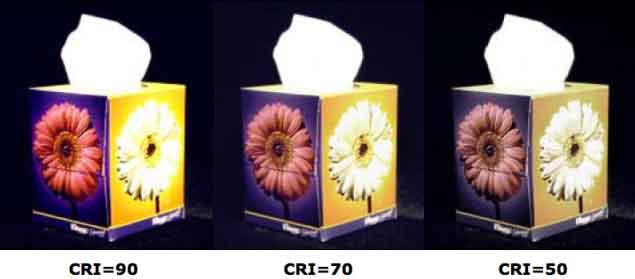
Jump to top of page
CSD – The Certified Lighting Subcomponent Database – The Certified Subcomponent Database (CSD) supports qualification of ENERGY STAR® Luminaires by providing certified performance data for lighting subcomponents.
The CSD is similar in purpose and function to the NEMA/ALA Lamp and Ballast Platform Matrix, but provides certified performance data required for qualification of ENERGY STAR luminaires The CSD can streamline the process of luminaire qualification by providing manufacturers’ makes, models and certified performance data of subcomponents. Depending on the type of luminaire, the subcomponents listed here may or may not meet the applicable requirements. In most instances, this approach to luminaire qualification significantly reduces the luminaire manufacturer’s testing burden, such that only limited additional testing is needed at the luminaire level (e.g., in situ temperature measurements and electrical safety testing). Further information is available on the CSD from the ENERGY STAR website here
Click here to view: ENERGY STAR Qualified Lamps vs. CSD
cUL – Canada underwriters laboratory.
Jump to top of page
DACROTIZED® – A super-high performance surface treatment system for corrosion prevention.
The coating-film structure and corrosion-preventive mechanism of DACROTIZED®
The solution (DACRODIP) used for the DACROTIZED® coating is a water-based dispersant containing metallic zinc flakes, chromic anhydride, glycol, etc. Soaking the target substrate in DACRODIP and heating the solution to approximately 300°C in an oven will reduce the by-production of hexavalent chromium by organic substances such as glycol. The resulting water-insoluble amorphous nCrO3·mCr2O3 is used as a binder that joins together the zinc flakes, which are laminated in several dozen layers, to produce a coating film. The chromic anhydride in DACRODIP also oxidizes and chemically bonds with the metal surface, thereby achieving a high degree of adhesion. The anti-corrosive mechanism of the DACROTIZED® coating film consists of the controlled galvanic protection action of zinc particles, the passivation of base metal by chromic acid and the barrier effect of zinc flakes and chrome compounds, all of which combine for a level of corrosion resistance that no ordinary coating can offer.

DAYLIGHT SENSOR – A device which senses the amount of daylight in a room and controls the luminaire accordingly.
Jump to top of page
DID (Direct/Indirect) – A source of light in which light is cast both upwards and downwards from a fixture to provide a combination of direct and indirect illumination.
Jump to top of page
DIRECT – A direct source of light which is cast downwards from a fixture to provide lighting with uniform levels of illumination. Open, louvered, and lensed fixtures can all be “direct”. Also see Indirect and Direct/Indirect.
Jump to top of page
DLC – Design Lights Consortium – Association of utility companies used to create and maintain a minimum performance standard for LED luminaires. (Visit DLC website.)
Jump to top of page
DOWNLIGHTING – Light which is cast downward from a fixture. The most common and direct form of lighting.
Jump to top of page
DRIVER (LED) – An LED driver is a self-contained power supply that has outputs matched to the electrical characteristics of your LED or array of LEDs. Understanding the electrical characteristics of your LED or array is critical in selecting or designing a driver circuit. Drivers should be current-regulated (deliver a consistent current over a range of load voltages). Drivers may also offer dimming by means of pulse width modulation (PWM) circuits. Drivers may have more than one channel for separate control of different LEDs or arrays.
Jump to top of page
E12 – See lamp base chart.
Jump to top of page
E26 – See lamp base chart.
Jump to top of page
E39 – See lamp base chart.
Jump to top of page
EFFECTIVE PROJECTED AREA (EPA) – The Effective Projected Area (EPA) of a fixture is equal to the area “visible” by the wind at a particular angle. All pole mounted fixtures and mounting hardware have EPA values/ratings. All poles have maximum weight and EPA capacities. To calculate the EPA of any particular fixture configuration simply add the EPA values of the fixture(s) and mounting bracket(s) to be mounted. The total EPA & weight mounted on any pole must not exceed the pole’s maximum rating for the wind zone in which it is located.
EPA Example Calculation
Existing Pole: 25’, 5” Square Steel Pole
Pole EPA Rating = [70 mph, 36.5], [80 mph, 26.0], [90 mph, 19.0], [100 mph, 14.0], [120 mph, 8.0]
Proposed Fixtures: (2) fixtures with an EPA of 2.48 and (2) bolt on arms with an
EPA of 0.3
Calculation: [2 x 2.48] + [2 x 0.3] = 5.56 < 8.0
This configuration is suitable for wind zones up to 120 mph.
EFFICACY, LIGHTING – The ratio of light from a lamp to the electrical power consumed, including ballast losses, expressed as lumens per watt.
Jump to top of page
ENERGY STAR® – EPA brand that creates a minimum performance standard for many household items and appliances including light bulbs and fixtures. (Visit ENERGY STAR website.)
ESCO – Energy Service Company. A company dedicated to helping commercial and industrial clients reduce their energy consumption.
Jump to top of page
ETL – ETL (formerly Edison Testing Laboratory) is a division of Intertek Group specializing in electrical product safety testing, EMC testing, and benchmark performance testing. (See UL)
Jump to top of page
FC – Foot-Candle. A unit of measure for the density of light as it reaches a surface. One foot-candle is equal to 1 lumen per square foot.
Jump to top of page
FLOOD LIGHT – Any directional lighting source that floods a wide area or wall surface with light.
Jump to top of page
GLARE – Glare is a visual sensation caused by excessive and uncontrolled brightness. It can be disabling or simply uncomfortable. It is subjective, and sensitivity to glare can vary widely. Older people are usually more sensitive to glare due to the aging characteristics of the eye.
Jump to top of page
HI-BAY – Lighting used in industrial applications where the ceiling height is greater than 15 to 20 feet. Common in big box retail, industrial, warehouse and manufacturing spaces.
Jump to top of page
HID – High Intensity Discharge lamps. Includes HPS, PSMH, MH and MV lamps.
Jump to top of page
HIGH EFFICIENCY BALLAST – A lighting conservation feature consisting of an energy-efficient version of a conventional electromagnetic ballast. The ballast is the transformer for fluorescent and high-intensity discharge (HID) lamps, which provides the necessary current, voltage, and wave-form conditions to operate the lamp. A high-efficiency ballast requires lower power input than a conventional ballast to operate HID and fluorescent lamps.
Jump to top of page
HPS – High Pressure Sodium HID Lighting.
Jump to top of page
IC (Insulation Contact) Rated – describes an electrical fixture that does not require a clearance between the fixture and insulation material.
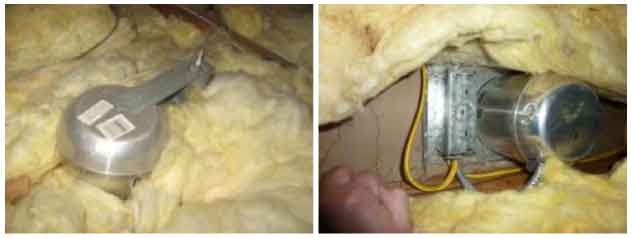
ILLUMINANCE – Light arriving at a surface, expressed in lumens per unit area; 1 lumen per square foot equals 1 footcandle, while 1 lumen per square meter equals 1lux.
Jump to top of page
INDIRECT – An indirect source of light which is cast upwards from a fixture and bounced down to provide lighting with minimal glare and more uniform levels of illumination.
Jump to top of page
INITIAL LUMENS – The lumens produced by a lamp after an initial burn in period (usually 100 hours).
Jump to top of page
INPUT WATTS – The total wattage required by both the ballast and the lamp in a luminaire.
Jump to top of page
INSTANT START – Ballast starting type. Applies high voltage across the lamp with no preheating of the cathode.
Jump to top of page
IP RATING – See chart below.
KELVIN TEMPERATURE – A numerical scale used to describe the color of light. Light with a lower Kelvin rating will have a more yellow tint, while light with a higher kelvin rating will have a more blue tint.
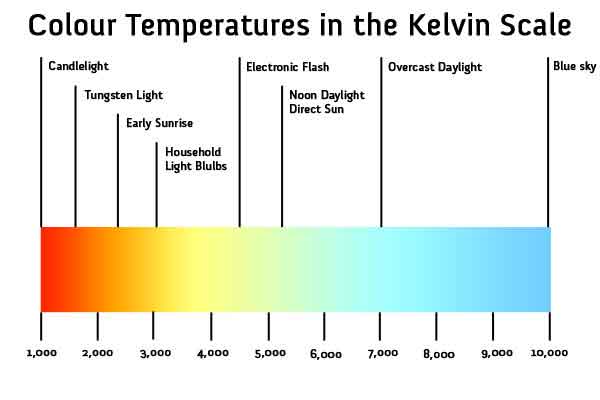
Jump to top of page
KILOWATT – 1000 Watts.
Jump to top of page
KILOWATT HOUR – 1000 Watts used continuously for one hour.
Jump to top of page
L70 – The term “L70” is used to describe the LED’s expected light output over its stated life span. “L70” means that at the defined life time (hours) the LED product will emit a minimum of 70% of its initial light output.
i.e. “L70” @ 35,000 hours – only 70% of the initial lumens will be provided.
Jump to top of page
LAMP – The source of light in a fixture, colloquially called a “light bulb.”
Jump to top of page
LAMP BASE SIZES – See chart below.
LAMP DISPOSAL – Refers to the proper recycling of lamps containing mercury or other hazardous materials.
Jump to top of page
SHUNTED VS. UNSHUNTED LAMPHOLDERS
- Shunted Lampholders – will have 2 holes (or accept 2 wires) on the unit.
- Unshunted Lampholders – will have 4 holes (or accept a total of 4 wires) on the unit.
Shunted Lampholders are to be used with Instant Start Ballasts, and Unshunted Lampholders are to be used with Rapid Start Ballasts. An unshunted lampholder may be converted to a shunted lampholder by taking a short wire and stripping both ends. Next take one end of the wire and insert it into one hole on the left side of the lampholder, taking the other end and stick it into one of the holes on the right side of the unit. Thus, making a jump from one side to the other, and now it becomes a shunted lampholder.
LAMP LIFE – A measure of lamp performance, as measured in median hours of burning time under ANSI test conditions.
Jump to top of page
LENS – A glass or plastic element used in luminaries to seal a fixture or control the exiting light.
Jump to top of page
LIGHT DISTRIBUTION PATTERNS – Outdoor luminaires produce lighting patterns that can be identified first by their reach in front of a single fixture location and second by their reach on each side of that location. “Distribution types” describe the reach of the luminaires light pattern forward of each fixture, while “distribution ranges” define the reach to either side.
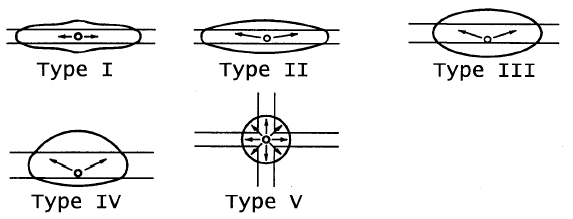
Distribution Types
The term “distribution type” defines how far forward of the luminaire (i.e., on the street side) the effective output reaches. The specific classification of distribution types is based on locating the luminaires effective major output pattern on a grid representing distances in units of Mounting Height (MH) from the luminaire. This pattern is defined by tracing an area representing light distribution at 50% of maximum candela. By measuring where the bulk of this pattern falls on the grid, a luminaire can be classified as follows and as shown in Figure 5. Refer to illustrations of definitions online. (Note that in some cases, minor deviations in a beam pattern may cross the boundary from one type into another. While this has a nominal effect on applied performance, it should not be considered for classification purposes.1):
- Type II defines shallow reaches, when the 50% maximum candela trace lies within1.75 MH on the street side of the reference line.4
- Type III is a mid-range, when the 50% maximum candela trace lies within 2.75 MH on the street side of the reference line.4
- Type IV identifies luminaires with a definite forward-throw distribution, when the 50% maximum candela trace lies beyond 2.75 MH on the street side of the reference line.4
- Distribution is classified as Type V Square for horizontal lamp luminaires when the 50% maximum candela trace is symmetric in four quadrants. This distribution is characterized by four candela peaks, diagonal to the reference line.
- Asymmetric5,6 Distribution (similar to Type III): This distribution is for vertical lamp luminaires when the 50% maximum candela trace lies beyond 1.0 MH on the street side of the reference line, and inside 1.0 MH on the house side of the reference line. Narrow range distribution is identified when the point of maximum candela falls inside of 2.25 MH; wide range is identified when the point of maximum candela falls beyond 2.25 MH.
- Symmetric5,6 Square Distribution (similar to Type V Square): Distribution is classified as symmetric square for vertical lamp luminaires when the 50% maximum candela trace is symmetric in four quadrants on both street and house side of the reference line. Narrow range distribution is identified when the candela peaks fall inside of 2.25 MH along the reference line; wide range is identified when the candela peaks fall beyond 2.25 MH.
LIGHTING FACTS LABEL – FTC federal trade commission requirement for all light bulbs. DOE label for LED bulbs and luminaires has all information verified by third party labs. (Visit Lighting Facts website.)
See below for label types.
- Black/White Lighting Facts Label
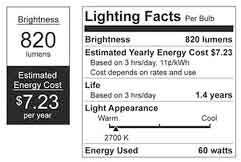
- Color Lighting Facts Label
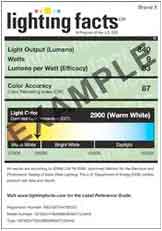
LLD – Lamp Lumen Depreciation Factor. The multiplier to be used in illumination calculations to relate the initial rated output of light sources to the anticipated minimum rated output based on the relamping program to be used. (See also Lumen Depreciation and Mean Lumens).
Jump to top of page
LLF– Light Loss Factor. A factor used in calculating illuminance after a given period of time and under given conditions. It takes into account temperature and voltage variations, dirt accumulation.
Jump to top of page
LM-80– IESNA approved method of measuring Lumen depreciation of LED Light sources. It is related to the effective useful life of the product.
Jump to top of page
LM79– IESNA approved method for the electrical and photometric test of solid state lighting devices. Specifies procedures for measuring total luminous flux electrical power, luminous efficacy.
Jump to top of page
LO-BAY – Lighting used in industrial applications where the ceiling height is 15 to 20 feet or less. Common in big box retail and industrial settings.
Jump to top of page
LPW – Lumens Per Watt. The number of lumens produced by a light source for each watt of electrical power supplied to the light source. See Efficacy, Lighting
Jump to top of page
LUMEN DEPRECIATION – The decrease in lumen output of a light source over time; every lamp type has a unique lumen depreciation curve (sometimes called a lumen maintenance curve) depicting the pattern of decreasing light output.
Jump to top of page
LUMEN MAINTENANCE – The deterioration in the amount of light that is emitted from a lamp over time. A lamp with a good lumen maintenance will emit a consistent amount of light over its lifetime, emitting as much as 90% of its original capability at the end of its lifespan. A lamp with poor lumen maintenance will lose as much as 50% of its ability to emit light over time.
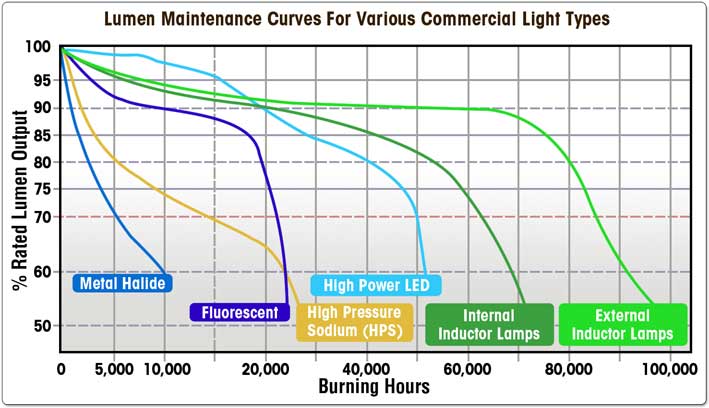
Jump to top of page
LUMENS – A unit of luminous flux; overall light output; quantity of light, expressed in lumens.
Jump to top of page
LUMINAIRE – A complete lighting unit which contains a lamp, housing, ballast, sockets and any other necessary components.
Jump to top of page
LUMINAIRE EFFICIENCY – The ratio of lumens emitted by a luminaire to the total lumens emitted from the light source within the luminaire.
Jump to top of page
LUX – A unit of illuminance equal to 1 lumen per square meter.
Jump to top of page
MEAN LUMENS – The average lumen output of a lamp over its rated life. Mean lumen values for fluorescent and HID lamps are typically measured at 40% of their rated lives.
Jump to top of page
MH – Metal Halide HID lighting.
Jump to top of page
OCCUPANCY SENSOR – A device which activates a fixture upon sensing the presence of a person.
Jump to top of page
Omnidirectional – Capable of transmitting or receiving signals in all directions, as an antenna, radio signals or microphone. In the case of lighting, omnidirectional is the transmitting of light in all directions.
Jump to top of page
PHOSPHORS – Substances which emit light after being bombarded by electrons. Phosphors are used to coat the inside of fluorescent lamps.
Jump to top of page
PHOTOPIC LUMENS – A type of light measured in lumens that is generally detected by common light meters and accounts for part of the human eye’s perception of brightness.
Jump to top of page
POWER FACTOR – A measure of the effectiveness with which an electrical device converts volt-amperes to watts;devices with power factors (> 0.90) are “high power factor” devices.
Jump to top of page
PROTOCOLS – See Controls
Jump to top of page
PS (Programmed Rapid Start) – A method of starting fluorescent lamps, associated with electronic ballasts, where low voltage is applied to the cathode prior to lamp ignition. Recommended for use with occupancy sensors.
Jump to top of page
PSMH – Pulse Start Metal Halide HID Lighting.
Jump to top of page
RAPID START – A method of starting typically associated with magnetic ballasts; where a low filament voltage is applied to preheat the cathodes.
Jump to top of page
RE-STRIKE – Refers to the restarting of a previously operating lamp shortly after turnoff. Metal halide lamps typically require a minimum of 4-15 minutes to restart after turn-off.
Jump to top of page
RETROFIT – Install new equipment or technology into older existing machines or equipment; modify something by adding newer and more advanced equipment (i.e. retrofit an old HID fixture with an energy efficient light source.)
Jump to top of page
RLO – Relative Light Output. The ratio of light output between a fixture’s potential light output at optimum ambient temperatures and actual light output at actual ambient temperatures. For example, if a fixture at its optimal temperature of 75°F produces 10,000 Lumens and 8,000 Lumens 50°F, that fixture’s RLO at 50°F is 8,000 Lumens ÷ 10,000 Lumens, or 80%.
Jump to top of page
RoHS – Restriction of Hazardous Substances (RoHS) is a European directive that establishes a set of product safety restrictions that ban materials such as lead, mercury and cadmium from electronics. Over the past decade RoHS laws have been spreading around the globe.
Jump to top of page
Room Cavity Ratio (RCR) – A ratio of room dimensions used to quantify how light will interact with room surfaces. A factor used in illuminance calculations. RCR = 5H (L+W) / L x W, or, alternately, RCR = (2.5) Total Wall Area / Floor Area. Where H = height, L = length and W = width of the room. A cubical room will have an RCR of 10; the flatter the room the lower the RCR.
Jump to top of page
S/P RATIO – The ratio of scotopic to photopic lumens produced by a light source. An appropriate S/P ratio will provide for a more comfortable atmosphere and better perceived brightness.
Jump to top of page
SCOTOPIC LUMENS – A type of light that is not generally detected by common light meters but which accounts for part of the human eye’s perception of brightness.
Jump to top of page
SELF BALLASTED – A self ballasted bulb is one that has an integral ballast and bulb as a single component. Example- most CFL bulbs are self ballasted and most linear lamps are not self ballasted.
Jump to top of page
SPOT LIGHT – A lamp projecting a narrow, intense beam of light directly onto a place or person, esp. a performer on stage.
Jump to top of page
STERADIAN – The SI unit of solid angle, equal to the angle at the center of a sphere subtended by a part of the surface equal in area to the square…
Jump to top of page
T12 – 1 1/2″ diameter fluorescent lamps. See Bulb Shape And Size
Jump to top of page
T5 – 5/8″ diameter fluorescent lamps. “T” stands for tubular, while the number “5” stands for the 5 in 5/8″. Therefore a T8 lamp would be a Tubular 8/8″, or 1″ diameter lamp. See Bulb Shape And Size
Jump to top of page
T8 – 1″ diameter fluorescent lamps. See Bulb Shape And Size
Jump to top of page
THD – Total Harmonic Distortion. A measure of the distortion of an electrical wave form. Excessive THD (defined by ANSI as greater than 32%) may cause adverse effects to the electrical system.
Jump to top of page
THERMAL CHARACTERISTICS – The manner in which a luminaire manages heat, either dissipating heat or retaining it.
Jump to top of page
TM21 – TM-21 document presents a method for lumen-depreciation projection based on LM-80 data, enabling LED lifetime extrapolations beyond 6000 hours.
Jump to top of page
TROFFER – A recessed luminaire shaped like an inverted trough used to enclose and reflect fluorescent lamps.
Jump to top of page
UL – Underwriters Laboratory (safety certifying body.)
Jump to top of page
UPLIGHTING – A source of light which is cast upwards to illuminate a ceiling cavity for aesthetic reasons. When combined with reflective ceiling materials, uplighting can function as a source of indirect lighting.
Jump to top of page
US PATENT – A patent for an invention is the grant of a property right to the inventor, issued by the United States Patent and Trademark Office. Generally, the term of a new patent is 20 years from the date on which the application for the patent was filed in the United States or, in special cases, from the date an earlier related application was filed, subject to the payment of maintenance fees. U.S. patent grants are effective only within the United States, U.S. territories, and U.S. possessions. Under certain circumstances, patent term extensions or adjustments may be available. The right conferred by the patent grant is, in the language of the statute and of the grant itself, “the right to exclude others from making, using, offering for sale, or selling” the invention in the United States or “importing” the invention into the United States. What is granted is not the right to make, use, offer for sale, sell or import, but the right to exclude others from making, using, offering for sale, selling or importing the invention. Once a patent is issued, the patentee must enforce the patent without aid of the USPTO.
There are two types of patents:
1.) Utility patents may be granted to anyone who invents or discovers any new and useful process, machine, article of manufacture, or composition of matter, or any new and useful improvement thereof;
2.) Design patents may be granted to anyone who invents a new, original, and ornamental design for an article of manufacture;
Jump to top of page
VOLTS – The SI unit of electromotive force, the difference of potential that would carry one ampere of current against one ohm resistance.
Generally- 120V= residential and light commercial
277V= commercial and light industrial
347V= commercial and light industrial (Canada only)
480V= heavy industrial
Jump to top of page
WATTS – An International System unit of power equal to one joule per second.
Jump to top of page

